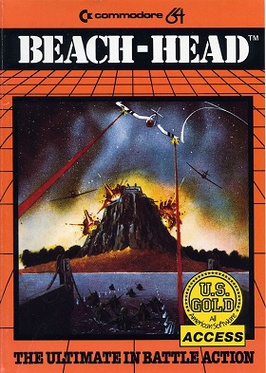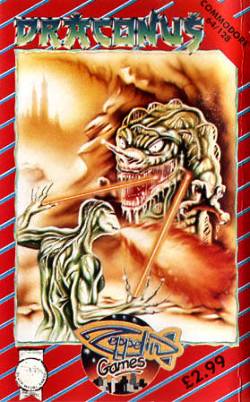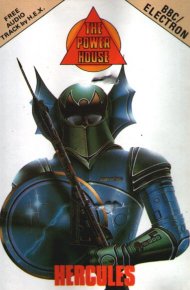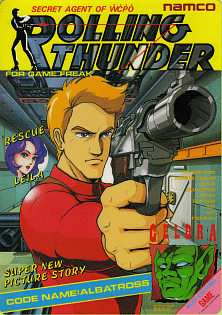
The Great Giana Sisters is a platform game developed by the West German company Time Warp and published by Rainbow Arts in 1987 for home computers such as the Commodore 64, Amiga and Atari ST. Players control Giana to explore a magical world inside their dreams; to wake up, they must find a giant diamond. They traverse side-scrolling stages while avoiding hazards such as monsters and other enemies. These can be defeated by using power-ups, which grant the player abilities such as firing projectiles and making enemies fall asleep.

Mayhem in Monsterland is a 1993 platform game for the Commodore 64. Its titular hero, "Mayhem", is a yellow triceratops blessed with the gift of speed. His goal is to return his world from sad to happy, ridding the world of monsters along the way.

Conan: Hall of Volta is a platform game from American developers Eric Robinson and Eric Parker and published by Datasoft in 1984. It is based on the character Conan created by Robert E. Howard. This game was originally written for the Apple II and ported to the Commodore 64 and Atari 8-bit computers.

Wizards & Warriors, titled Densetsu no Kishi Elrond in Japan, is an action platform video game developed by Rare and published by Acclaim Entertainment for the Nintendo Entertainment System. It was released in North America in December 1987, and in Europe on January 7, 1990. The player controls Kuros, "Knight Warrior of the Books of Excalibur", as he sets out in the Kingdom of Elrond to defeat the evil wizard Malkil. Malkil holds the princess of Elrond captive in Castle IronSpire, deep within the forests of Elrond. The player fights through forests, tunnels, and caves, while collecting keys, treasure, weapons, and magic items.

Star Goose is a vertically scrolling shooter that was published for the Amiga, Atari ST, and MS-DOS by Logotron in 1988. The player controls Scouser-Gitt, who pilots the eponymous Star Goose, a vessel that has been commissioned to scour the planet Nom and collect 48 crystals. Players must collect all six crystals in each of the game's eight levels to advance, while at the same time avoiding or destroying enemies and maintaining their shield, ammunition, and fuel levels. The game's surfaces are contoured, which affects the way that bullets travel, and contain tunnels that switch modes to a three-dimensional perspective where the player can replenish their resources.

H.E.R.O. is a video game designed by John Van Ryzin and published by Activision for the Atari 2600 in March 1984. The game has players control Roderick Hero who traverses a mineshaft avoiding enemies and hazards to rescue trapped miners. He travels through the mines equipped with a hoverpack that allows him to traverse the game levels as well as bombs and laser that let him destroy walls and defeat enemies respectively.

Rygar is a 1986 side-scrolling platform game created by Tecmo. Originally released for Japanese arcades in June 1986, the game was subsequently ported to the NES (1987), Commodore 64 (1987), ZX Spectrum (1987), Amstrad CPC (1987), Master System (1988), Atari Lynx (1990), and X68000 (1994). Emulations have also been released for Xbox (2005), Sprint mobile phones (2005), Wii (2009), PlayStation 4 (2014), Nintendo Switch (2018), and Android (2023), with an unofficial fan-made emulation released for Amiga AGA in 2019. A remake, Rygar: The Legendary Adventure, was released for PlayStation 2 in 2002. The Legendary Adventure was remastered for the Wii in 2008 as Rygar: The Battle of Argus.

Jukka Tapanimäki was a Finnish game programmer from Tampere, Pirkanmaa. Tapanimäki wrote his games for the Commodore 64 computer, and many have been ported to other computer systems. Tapanimäki was a reviewer for MikroBitti and "C" computer magazines; and a freelance writer of advanced-level computer programming articles. He also published a book called C-64 Pelintekijän Opas in 1990.

Netherworld is a shoot 'em up video game published by Hewson in 1988. It was originally developed by Jukka Tapanimäki for the Commodore 64, and original music was composed by Jori Olkkonen.

Druid is a hack and slash dungeon crawl developed by Electralyte Software and published by Firebird in 1986 for the Atari 8-bit computers, and Commodore 64. It was also ported to Amstrad CPC, ZX Spectrum, and by Nippon Dexter in 1988 for the MSX, although the MSX port was released in Japan only. Another Japanese port of Druid entitled Druid: Kyōfu no Tobira (ドルイド 恐怖の扉) was made for the Famicom Disk System by Jaleco in 1988. The game was followed by Druid II: Enlightenment and Warlock: The Avenger.

Beach-Head is a video game developed and published in 1983 by Access Software for the Atari 8-bit computers and Commodore 64 in the US. Versions for the ZX Spectrum, BBC Micro, and Acorn Electron were published in Europe by U.S. Gold in 1984, followed by versions for the Amstrad CPC, Commodore 16 and Plus/4 in 1985.

Katakis is a horizontally scrolling shooter developed for the Commodore 64 by Rainbow Arts in 1987, and converted to the Amiga by Factor 5 in 1988. It was re-released as Denaris in 1989. The name Katakis has a Greek origin and was found in a phone book in Gütersloh, Germany. The name Denaris was created by a random name generator, and by coincidence, matches a Greek name as well.

Indiana Jones and the Temple of Doom is an action game released in 1988 for the Nintendo Entertainment System. The game is based on the arcade game and film of the same name. The resulting product differed from the arcade version in several aspects, but kept the same underlying premise and style.

Action Force: International Heroes is a video game released by Virgin Games in 1987 for the ZX Spectrum and Commodore 64, and in 1988 for the Amstrad CPC. The game is set in the world of the Action Force toys by Hasbro. The ZX Spectrum version of the game differs notably from the Commodore and Amstrad versions.

Cobra is a 1986 platform game based on the film of the same name. It was developed and published by Ocean Software, and was released in Europe for Amstrad CPC, Commodore 64 (C64), and ZX Spectrum. By 1990, it received a budget re-release.

Indiana Jones and the Temple of Doom is an action game developed by Atari Games and released in arcades in 1985. It is based on the 1984 film of the same name, the second film in the Indiana Jones franchise. It is the first Atari System 1 arcade game to include digitized speech, including voice clips of Harrison Ford as Indiana Jones and Amrish Puri as Mola Ram, as well as John Williams's music from the film.

Draconus is an action-adventure platform game developed and published by Zeppelin Games in 1988. It was released for the Atari 8-bit computers, Commodore 64, and ZX Spectrum. Draconus is similar to Metroid.

Rupert and the Toymaker's Party is a video game developed by Martin Walker and published by Quicksilva in 1985. It was developed for the Commodore 64 and ZX Spectrum.

Hercules is a platform video game written by Steve Bak for the Commodore 64 and published by Interdisc in 1984. It was reissued in 1986 by Alpha Omega and ported to the Acorn Electron, BBC Micro, Commodore 16, Plus/4, and ZX Spectrum. Alpha Omega changed its name to The Power House shortly after publishing the game.

Rolling Thunder is a run and gun video game developed by Namco in Japan and Europe and released in 1986 as a coin-operated arcade video game using the Namco System 86 hardware. It was distributed in North America by Atari Games. The player takes control of a secret agent who must rescue his female partner from a terrorist organization. Rolling Thunder was a commercial success in arcades, and it was released for various home computer platforms in 1987 and the Nintendo Entertainment System in 1989. The original arcade game has been included in various classic game compilations as well. It influenced later arcade action franchises such as Shinobi and Time Crisis, which borrowed mechanics such as taking cover behind crates.



















